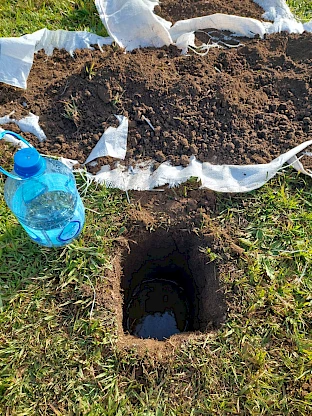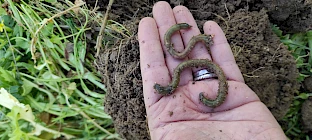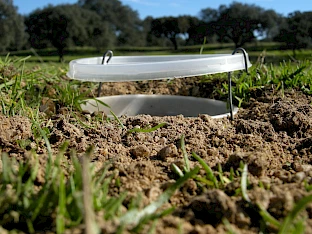Pls
José Paulo Sousa
Luís Cunha
Recognising soil not only as a substrate but as a dynamic biological entity, the Soil Health research group focuses on decoding the myriad interactions, processes, and mechanisms that make up the multiple facets of soil health. Adopting a holistic perspective, it seeks to elucidate the intricate balance between the physical, chemical and biological properties of soil, to define soil health metrics and to contribute to the development of sustainable soil management, restoration and conservation strategies, increasing its resilience and productivity in the face of different environmental challenges. By employing advanced analytical techniques, it aims to discern the profiles of microbial and faunal activity, the dynamics of organic and inorganic components, and the effects of the various stressors that influence different components of soil health. Anchored in a sustained dialogue between different actors, its mission is also to increase soil literacy by addressing and understanding the concerns that impact this vital resource. The information produced aims to offer informed suggestions contributing to the improvement of public policies, aiming to ensure the sustainability of ecosystems, essentially in the agricultural and forestry sectors. This group includes the following Research Lines (RLs)
RL1: Soil Ecology and Ecotoxicology
This RL focuses on understanding the interactions and dynamics in the soil ecosystem and the effects derived from different stressors to which it is subjected, particularly in agricultural and agroforestry systems. In general, the research developed aims to contribute to the adoption of practices that make it possible to increase or maintain soil health and the sustainability and resilience of these systems. It involves two main components: 1) "Soil Ecology" component, focused on the assessment of changes in the functional biodiversity of soil organisms (soil microorganisms, meso- and macrofauna) and the benefits of exploring "plant-microorganism" relationships with the aim of understanding and exploring their effects on soil ecological processes and the provision of ecosystem services. Particular emphasis is placed on the impacts of different management practices, land-use changes, landscape changes and extreme weather events; 2) "Terrestrial Ecotoxicology" component focused essentially on improving the development of ecological risk assessment processes for plant protection products (PPPs) for soil organisms and auxiliary arthropods (pollinators and pest control agents). The research is strongly aligned with the objectives and research of EFSA (European Food Safety Authority) in terms of the evaluation of the effects of new compounds and effects of realistic mixtures of PPPs, evaluation of the main factors that condition the bioavailability of these compounds for non-target organisms, as well as the effects of the application of these compounds on the biodiversity of these organism groups under field conditions. This RL involves elements from SEEL, ENGEL and B-Team laboratories.
RL 2: Nematode-Plant Interactions
This RL is specialised on researching phytoparasitic nematodes. Its members are active in: i) morphological, biochemical/molecular identification and quantification of phytoparasitic nematodes of the genera Globodera and Heterodera (cyst nematodes), Meloidogyne (root-knot nematodes), Pratylenchus (root lesion nematodes) and Bursaphelenchus, namely B. xylophilus (pine wood nematode (PMN)); ii) development of sustainable strategies for the control of phytoparasitic nematodes based on biological control agents, activators of plant defence mechanisms, trap crops and natural phytochemicals; iii) development of alternative and innovative methodologies to obtain cultivars resistant to phytoparasitic nematodes to be applied in horticulture, floriculture and fruit growing; iv) identification of genes/proteins related to the pathogenicity of phytoparasitic nematodes; v) study of the resistance mechanisms of Pinus spp. to MPN infection vi) monitoring and/or development of wood treatments for MPN elimination. This RL involves researchers from NEMATO-lab.
RL 3: Genomics of Biodiversity, Adaptation and Ecosystem Functionality
This RL develops a comprehensive approach to genomics, which includes the analysis of genes, genomes, metagenomes, transcriptomes and metatranscriptomes, in a constant effort to interconnect various disciplines. This approach provides in-depth insights into the taxonomy and diversity of existing organisms and their functional role in ecosystems. The research also delves into the evolutionary line and phylogeny of different organisms, aiming to evaluate their ability to adapt and acclimate to new environments and the effects of their exposure to environmental stress. By combining advanced technologies and experimental data, it aims to elucidate the intrinsic biology of organisms, their functional traits and complex interactions within the biotic and abiotic environmental dimensions. In general, the mission of this RL is to systematically decipher the functional landscape of the environment through the prism of genomics. This RL involves researchers from the ENGEL, SEEL and B-TEAM laboratories.
RL 4: Landscape Ecological Modeling
This RL is dedicated to understanding, simulating and predicting the interactions between ecological patterns and processes and the landscape. Involving a multidisciplinary team with strong knowledge of landscape ecology, it combines principles of ecology, geography and statistics to analyse the complex relationships between organisms and ecosystems. By including and integrating tools of Geographic Information Systems (GIS), remote sensing and mathematical modelling to capture the spatial and temporal dynamics of landscapes, the research developed allows to quantify and simulate ecological phenomena such as connectivity, habitat fragmentation, distribution of species (native and invasive), ecological niches, suitability of habitats/landscapes and biodiversity patterns. This approach facilitates the identification of ecological corridors, biodiversity hotspots, and areas at risk of ecological degradation. Research in this area is essential to develop effective conservation strategies and establish areas to protect and promote habitat connectivity. Researchers from the LEM, SEEL and BEWild laboratories are involved in this RL.









